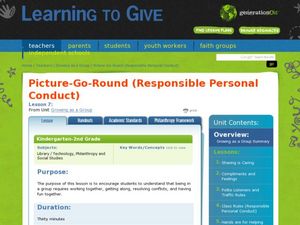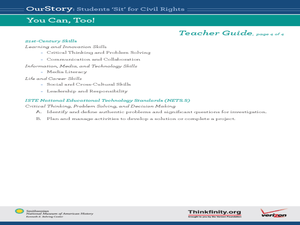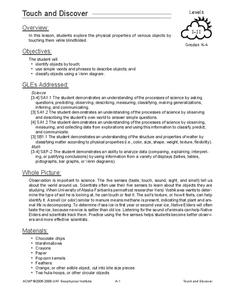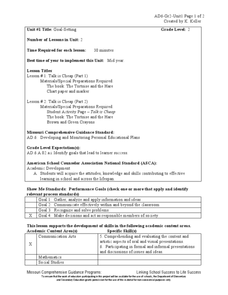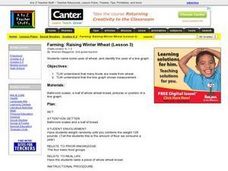Curated OER
Making Corn-Husk Dolls
Second graders create corn husk dolls. In this pioneers lesson, 2nd graders use corn husks, thread, scissors and simple cloth to create corn husk dolls. They discuss how the pioneer children used these toys, this discussion is intended...
Curated OER
Picture-Go-Round
Students demonstrate how to participate in a cooperative group. In this philanthropy instructional activity, students create drawings by working together as a group and contributing their thoughts and feelings.
Curated OER
Unique Family Traditions
Second graders examine unique family traditions. In this family tradition lesson, 2nd graders listen to a book about immigration. They interview a family member to determine where their ancestors came from and choose an article to share...
Curated OER
You Can, Too!
Young scholars and their parents participate in a volunteer opportunity in their community in order to solve a problem. In this problem solving lesson plan, students reflect on historical problems and see how they can solve a current...
Curated OER
Protest Signs
Students make their own chalk art or poster that represents a protest sign. In this protest sign lesson plan, students look at signs from the Civil Rights movement and then make their own.
Curated OER
Learning Musical Terms
Students investigate musical instruments and sounds by defining musical terms. In this music appreciation lesson, students define many vocabulary words and utilize a study sheet for memorization. Students are quizzed on the terms and...
Curated OER
Times Marches On
In this PowerPoint, students learn to distinguish between the terms "ancient" and "modern." The presentation gives visual and and written definitions of these words. Students respond to 5 questions that require them to decipher whether...
Curated OER
The Life of George Washington Carver--Vocabulary
In this George Washington Carver worksheet, students cut out the vocabulary words which focus on his life, and place them in alphabetical order. Students use the ten words in a sentence and staple them together to create a book.
Curated OER
Look At Those Leaves!
Students observe and sort tree leaves. In this earth science lesson, students observe the attributes of real leaves and measure leaves using Unifix cubes.
Curated OER
Dinosaurs 1: Where Are the Dinosaurs?
Learners explore the time of the dinosaurs. In this extinction lesson plan, students watch a video clip about different dinosaurs and are asked about what they observed. Learners talk about how dinosaurs hatched from eggs and compare...
Curated OER
Pond Life
Students explore pond ecosystems. In this living environment lesson, students observe the local pond and identify the living things they find by drawing pictures. Students observe organisms that were found in the pond by using a...
Curated OER
Touch and Discover
Students identify the physical properties of items using the sense of touch. In this touch and discover lesson, students describe items. Students sort items using a Venn diagram.
Curated OER
Discovering Dinosaurs
Students discuss theories about dinosaurs. In this dinosaurs and fossils lesson, students explore different scientific theories regarding dinosaurs and fossils. Students then come up with their own theories about why dinosaurs went...
Curated OER
Talking About Your Name in Math Terms
Add imagination and creativity to your math lesson. Young mathematicians investigate ways to express their names in mathematical terms. For instance, they can count the number of letters, analyze the geometric shapes of the letters, or...
Alabama Learning Exchange
Origami Geometry
Origami is an excellent way to combine Japanese culture, art, and geometric shapes into one engaging instructional activity! Scholars begin by listening to the story Sadako and the Thousand Paper Cranes and learn the origin of the...
Curated OER
Writing to a Specific Topic
After a class discussion where learners make predictions about what will happen in a book based on its cover illustration, pupils are asked to compose a written response about an aspect of the story and include some of their own...
Curated OER
Talk is Cheap
Second graders listen to the tale, "The Tortoise and the Hare" and discuss the moral of the story. Afterward, they brainstorm words that encouraged the Tortoise to accomplish his goal. Students then review the concept of goal setting and...
Curated OER
Vocabulary Development
By utilizing a graphic organizer called a bubble map, young readers work toward developing their vocabulary. After reading a story, a word that has something to do with the story is put in the middle circle. Then, other words that have...
Curated OER
Spice Up Your Life
Second graders identify major spices found in the world. They link spices with countries they are grown in and the uses for these valuable items.
Curated OER
Astronomy Unit: For Autistic Learners
In need of a few great ways to teach an arts-enriched lesson on astronomy? This resource contains several interesting ideas that link poetry to the stars in the sky. These suggestions are very simple and could use a teachers touch, but...
Curated OER
Weather Wonderland
Second graders explore the types of tools that scientists use t o study weater,
Curated OER
What's So Bad or Good About Conflict?
Young scholars investigate how conflict can be positive or negative. They discuss the concept of conflict while making a class web of their ideas. They design a class bulletin board that includes a thought written by each student after...
Curated OER
Flags
Students study the flag they describe in their writing. This is done by either having the entire class view the one flag they are describing, or by handing out pictures of various flags to each individual student.
Curated OER
Farming: Raising Winter Wheat (Lesson 3)
Students identify foods that are made from wheat. They use a line graph to explain measurement. They identify foods from the food groups and explain how temperature, prefcipitation and natural resources affect the growth of wheat.



